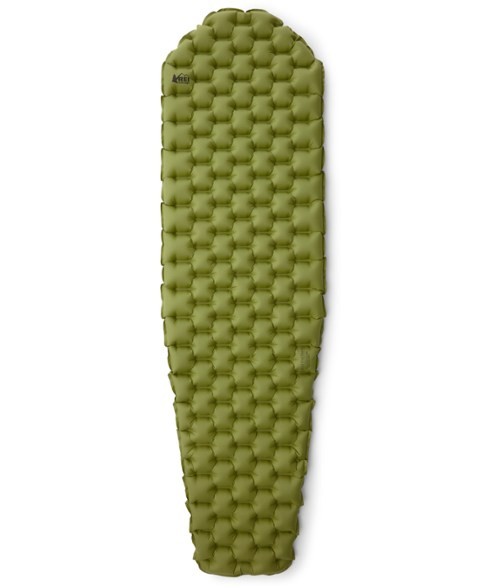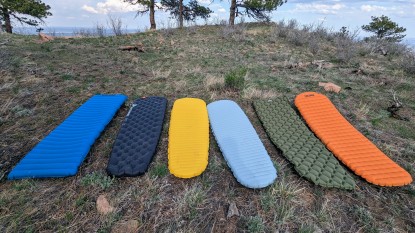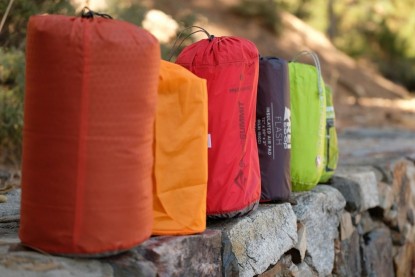REI Co-op Flash Thermal Review
Our Verdict
Our Analysis and Test Results
If we were to select an overall thesis to work around when describing the performance of this sleeping pad, it would be jack of all trades and master of none. We found many decent nights sleep with this pad but felt at times that we wanted either a bit more comfort, warmth, or a larger footprint to accommodate large framed testers. That said, it performs admirably, especially when considering the discount when compared to the top end pads we tested.
Comfort
Overall the comfort offered by the Flash Thermal is entirely adequate, with a few notable pros and cons. When fully pumped up, the Thermal offers about two inches of quilted padding. The separated air chambers do an excellent job of eliminating any bouncy that is often associated as a negative attribute of inflatable sleeping pads. The direct downside of this two-inch quilted pattern is that poking through to the ground is relatively easy. If propped up on elbows or side sleeping, this quilted pattern and thinner level of padding could be problematic. When flat on our back or front, we did feel completely suspended and quite comfortable.
If you spend a notable amount of time propped up scouring maps or reading, you may find the overall thickness of this pad lacking. If you strictly sleep on your back and use your sleeping pad for, well, sleep, the two inches is far superior to a closed-cell foam pad and offered a nice bounce-free night's slumber.
Weight and Packed Size
The regular mummy Flash Thermal we tested weighed in on our scale at one pound, 4.5 ounces; this is right around the advertised weight and ultimately isn't too heavy. This is certainly heavier than other pads that boast higher R-values and thicker padding, which is important to note for those wanting to optimize their weight to performance ratio. That being said, there are undoubtedly other pads that weigh a ton more, and REI has done an excellent job keeping weight down without blowing the costs out of the water.
The packed size is a similar story as the weight, “good, not great”. Again other pads boast a tighter package with better insulation and lower overall weight but not by too much.
Warmth
Throughout our testing period, we felt the Flash Thermal offered adequate warmth and insulation from the cold ground. Our testing took us into alpine/subalpine environments where the air temps were solidly below freezing, and we didn't feel any excessive leakage of heat. Our main tester does suspect that the quilted pattern and gaps in insulation could present a significant problem if attempting to pitch this pad directly on cold rock or ice/snow as visible areas are lacking the necessary shielding keeping warm air on one side and cold on the other. The Flash 3-season pad had a similar issue and did leave us with chattering teeth a few cold nights in the fall. In either case, having a solid closed-cell foam pad to supplement with would solve this problem adequately.
Ease of Inflation
Despite being in the minority of sleeping pads shipped without a pump sack, the Flash Thermal inflates extraordinarily quickly. Both the Thermal and Three Season share a quilted pattern that incorporates welds between each chamber, greatly reducing the amount of air needed to fully inflate the pad. Michael Phelps could probably inflate this pad with one lung load of air; it took our testers a few more, but sub ten breaths seemed to get the job done and with a minimal head rush. As always, the omission of a pump sack invites warm, humid air into the pad and creates a significant potential for mold/mildew to develop inside the pad, bringing overall durability into question.
Durability
Throughout our testing period of a few months, we didn't experience any weekend ruining durability issues at all. Before selecting products, we did see negative reviews regarding the pad developing leaks easily though we did not experience this. Overall the construction of the pad seems relatively durable. Thirty d fabric (a bit heavier than ultralight pads) was used throughout, adding a bit of confidence over some of the paper-thin options out there. The dual valve system works but lacks the robust feel of the top end pads.
The rubber valves feel a bit more on the plasticky fragile end of the spectrum when put side by side with the playable and dense materials used by the big boys. It's important to note that this could be purely aesthetic, as the valves did not fail or leak during testing. Finally, the dual valves are designed to be on the underside of the pad. This could be an issue of they are getting crushed into the dirt and would likely cause the anti-backflow valves to leak. We were careful to utilize a ground cloth, which is just good practice and adds a bit of a moisture barrier between the ground and your pad material anyway.
Value
The Flash Thermal sleeping pad is a jack of all trades when it comes to satisfying what we look for in a sleeping pad. While it does get the job done consistently, it lacks the razzle-dazzle we have come to expect from our award-winning products. The Thermal also lacks a jaw-dropping price tag, which is nice. Ultimately we feel like the Thermal represents a pretty good value and has enough versatility to see you through a massive variety of potential adventures.
Conclusion
While we won't be packing up the Flash Thermal on our next thru-hike, it's a nice, versatile all-arounder. Ultimately it's a little heavier, less comfortable, and lacking the heavy-hitting insulation we want out of a pad we will rely on for comfort months on end. That said, it does offer enough of each to get out on a backpacking trip in relative comfort without completely emptying the budget like some of the top options.











